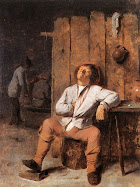White Poppies?
In 1933, the Women's Cooperative Guild began producing white poppies as a symbol of peace and the end of all wars. The Peace Pledge Union took up the white poppy in 1934 and continue to produce it as an alternative to the red poppy. The Peace Pledge Union began after the canon of St. Paul's cathedral asked people to send postcards promising never to support war. This dubious promise was taken up by a large number of Britons and their membership soon swelled. According to the White Poppy for Peace website (run by the PPU, the white poppy stands for a pacifist solution to war:
The White Poppy symbolises the belief that there are better ways to resolve conflicts than killing strangers. Our work, primarily educational, draws attention to many of our social values and habits which make continuing violence a likely outcome.The large difference between the red poppy and the white poppy is that the white poppy is meant not only to remember all the victims of war, but also to support pacifism. Of course, the implication is that wearers of the red poppy would rather see the continuance of war (and support arms sales, nuclear weapons, and the killing of 10 million innocent children.) Wearers of the white poppy, besides their distasteful disrespect of veterans, have too much faith in humanity. I would never pledge to reject war, and not because I love war. On the contrary, like most people, I find war abhorrent. Still, I recognize that there are always going to be genocidaires, Hitlers, Pol Pots, militarism, greed, and ideological clashes. Thus, there will always be a need to protect and defend the defenceless. This is what the red poppy stands for, not only for remembering the dead, but also for carrying on their fight for justice. The red poppy should not be a political symbol that asks us to support wars whether our government is wrong or right. No, it should be a symbol of remembrance and of the fight for justice. In the words of Peter Tosh on his song Equal Rights: "Everyone is crying out for peace, no one is crying out for justice." We can demonstrate for an end to violence, but are we demonstrating for true peace? True peace, true shalom, encompasses justice a
From economic reliance on arm sales (Britain is the world second largest arms exporter) to maintaining manifestly useless nuclear weapons Britain contributes significantly to international instability. The outcome of the recent military adventures highlights their ineffectiveness in today's complex world.
Now 85 years after the end of the ‘war to end all war’ we still have a long way to go to put an end to a social institution which in the last decade alone killed over 10 million children.
 nd the restoration of all creation to God's original intent. This is something that we cannot have as long as humans, with all their evil and hate, are in the picture. We work for shalom, but we know it is not obtainable by human power. Unfortunately, as a last resort, justice must occasionally be obtained through violence. John McRae's powerful poem, In Flanders Fields, asks the reader to take up the battle so that the dead can rest in peace. McRae meant that we should take up arms and fight on, but also, I think, that we should honour their memory in all that we do in our society. These men and women fought for justice, and we should remain vigilant in protecting our communities and working for true shalom. The red poppy stands for peace too, but not a peace that is blind to the imperfections of humanity. We shall not forget.
nd the restoration of all creation to God's original intent. This is something that we cannot have as long as humans, with all their evil and hate, are in the picture. We work for shalom, but we know it is not obtainable by human power. Unfortunately, as a last resort, justice must occasionally be obtained through violence. John McRae's powerful poem, In Flanders Fields, asks the reader to take up the battle so that the dead can rest in peace. McRae meant that we should take up arms and fight on, but also, I think, that we should honour their memory in all that we do in our society. These men and women fought for justice, and we should remain vigilant in protecting our communities and working for true shalom. The red poppy stands for peace too, but not a peace that is blind to the imperfections of humanity. We shall not forget.

6 comments:
Great piece, John.
thanks Jono.
Hey John.
We're back in Ottawa finally, so if you've ever got a spare afternoon maybe we can do coffee or something. (613) 314-2541 utterlackofpoise@hotmail.com
I hope that you are doing well,
Thanks, I'll phone you sometime this week. Good to hear from you.
John,
You are a wise man. Your post reminded me of a piece from the Roman Catholic Church's catechism:
Respect for and development of human life requires peace. Peace is not merely the absence of war, and it is not limited to maintaining a balance of power between adversaries. Peace cannot be maintained on earth without safegaurding the goods of persons, free communication among men, respect for the dignity of persons and peoples, and the assiduous practice of fraternity. Peace is the "tranquillity of order." Peace is the work of justice and the effect of charity.
Amen.
Thanks Brian Dijkema (or Bob Dole?) I appreciate this piece you posted from the Roman Catholic Church's catechism, it is very powerful.
I hope we can see you when we visit Hamilton this Christmas.
Post a Comment